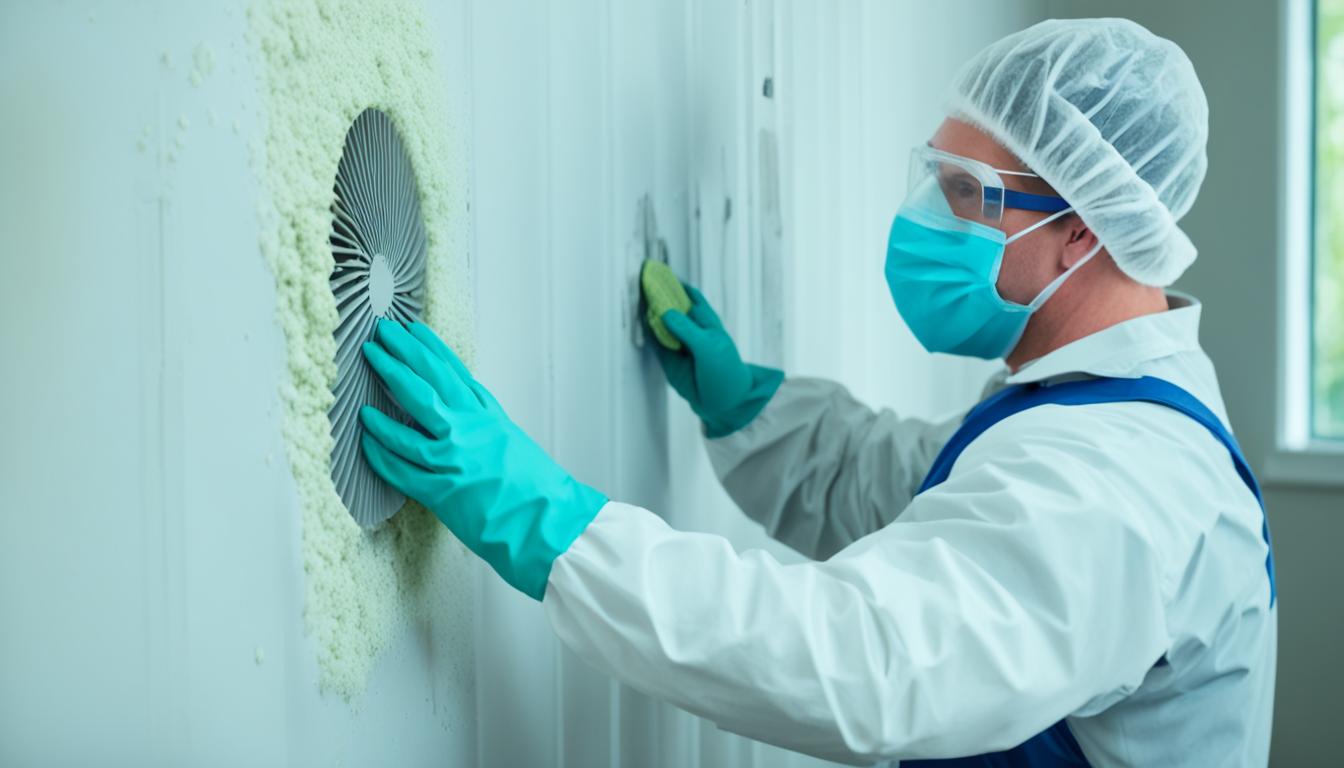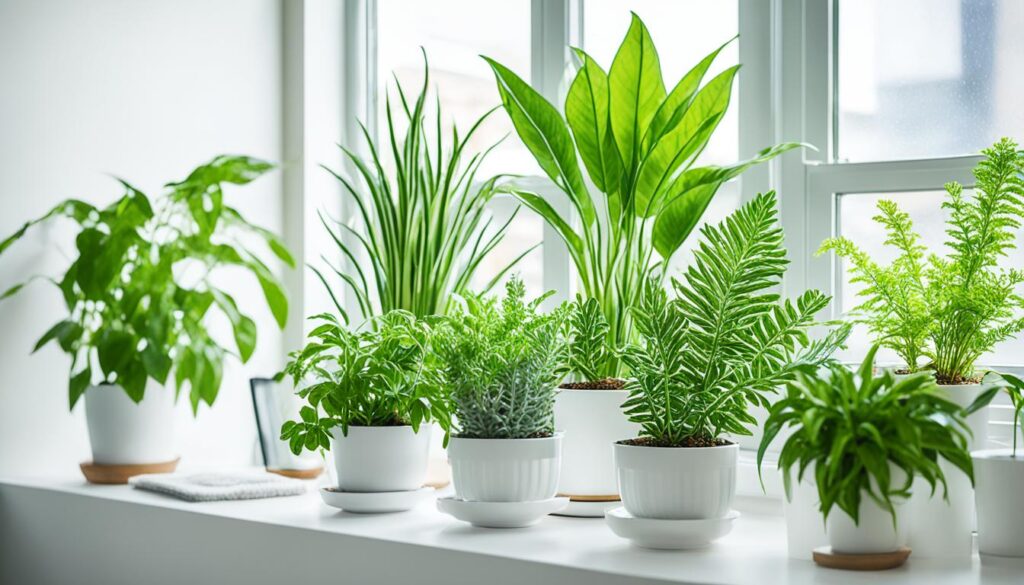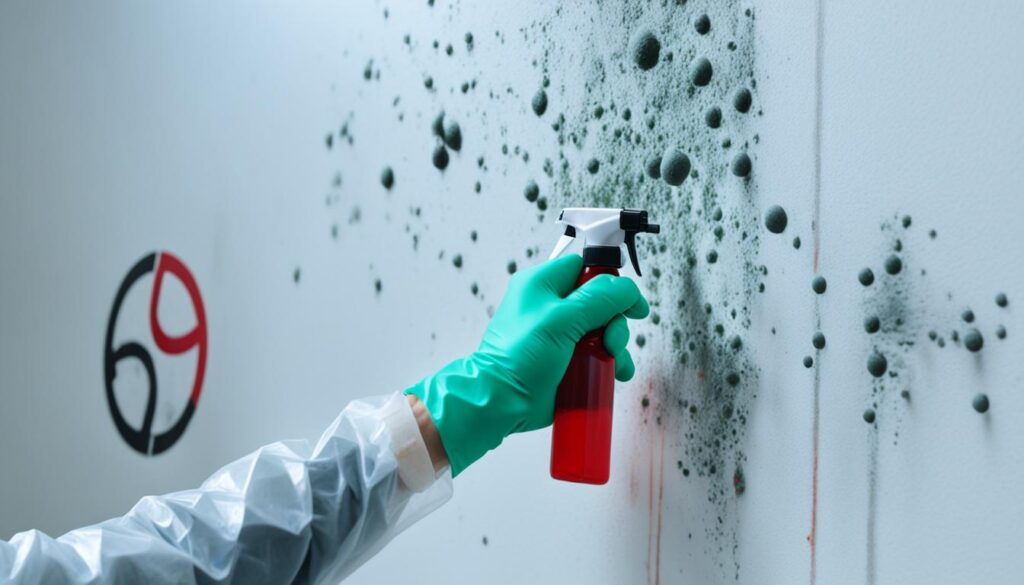
Mold Remediation: Fix Mold in Your Apartment Now
Dealing with mold growth in your apartment can be a frustrating and potentially hazardous experience. Not only can mold cause damage to your property, but it can also lead to respiratory issues and other health problems. In this section, we will discuss effective strategies for fixing mold in your apartment. By following these step-by-step mold remediation techniques and tips, you can ensure a healthier living space.
Key Takeaways:
- Identify the source of moisture that is promoting mold growth in your apartment.
- Wear protective gear, such as gloves and a mask, when cleaning mold to avoid inhaling spores.
- Use household cleaners or natural remedies like vinegar or hydrogen peroxide to remove surface mold.
- Consider using a mold removal spray to effectively eliminate mold from hard-to-reach areas.
- Ensure proper ventilation and control humidity levels in your apartment to prevent future mold growth.
Preventing Mold Growth in Your Apartment
Mold growth in your apartment can be a significant cause for concern. Besides being unsightly, mold can also contribute to respiratory issues and allergies. Fortunately, there are preventive measures you can take to stop mold from growing and maintain a healthy living environment.
Identify and Address Moisture Sources

Moisture is one of the main catalysts for mold growth. Identify and address any sources of moisture in your apartment as soon as possible. This could include fixing leaks in plumbing fixtures, repairing roof or window leaks, and ensuring proper ventilation in high-moisture areas like bathrooms and kitchens.
Control Indoor Humidity
Keeping indoor humidity levels below 50% is crucial in preventing mold growth. Invest in a hygrometer to monitor the humidity levels in your apartment. If you notice high humidity, use dehumidifiers or air conditioners to reduce moisture in the air. Don’t forget to empty and clean the water collection trays regularly to prevent mold from breeding.
Ventilate Properly
Proper ventilation is essential in preventing mold growth. Ensure that your apartment has adequate ventilation in areas prone to moisture, such as bathrooms and kitchens. Use exhaust fans when cooking or taking a shower to remove excess moisture from the air. Additionally, keep closet doors open to promote airflow and prevent stagnant air that can lead to mold growth.
Keep Your Apartment Clean and Dry
Mold needs organic matter to grow, so it’s important to keep your apartment clean and dry. Regularly clean and disinfect surfaces, especially in high-moisture areas. Use mold-resistant products when possible and thoroughly dry any wet items, such as towels or shower curtains, before storing them.
Monitor and Inspect Regularly
Regular monitoring and inspections can help you catch mold growth early on. Keep an eye out for any signs of mold, such as musty odors or discolored patches on walls or ceilings. If you notice any mold, take immediate action to address the problem and prevent further spread.
By implementing these preventive measures, you can greatly reduce the chances of mold growth in your apartment. Taking proactive steps to prevent mold will not only ensure a healthier living environment but also save you from costly mold remediation in the future.
DIY Mold Removal Techniques for Apartments
When it comes to dealing with mold in your apartment, taking immediate action is crucial. In this section, we will provide you with practical DIY methods for removing mold from your apartment. By following these techniques and procedures, you can safely and effectively eliminate mold growth on your own.
1. Identify the Problem Areas
Start by identifying the areas in your apartment that are affected by mold. Look for visible signs of mold, such as black spots on walls, ceilings, or floors. Pay attention to areas that are prone to moisture, such as bathrooms, kitchens, and basements. Remember, mold can also hide behind wallpaper, under carpets, and inside ventilation systems.
2. Gather the Necessary Tools and Supplies
Before you begin the mold removal process, gather all the necessary tools and supplies. This will ensure you have everything you need to tackle the job efficiently. Here are some items you might need:
- Protective gear: gloves, goggles, and a mask
- Scrub brush or sponge
- Bucket for mixing cleaning solution
- Mold cleaner or a solution of water and detergent
- Bleach (if recommended for the specific surface)
- Plastic bags for disposing of contaminated materials
3. Prepare the Area
Prior to starting the mold cleanup process, take the necessary precautions to protect yourself and prevent the spread of mold spores. Seal off the affected area by closing doors and covering vents with plastic sheets. Open windows for ventilation.
4. Remove the Mold
Now it’s time to remove the mold. Depending on the severity of the mold growth, you may need to use different techniques.
If the affected area is small, you can clean it using a mold cleaner or a solution of water and detergent. Scrub the surface gently with a brush or sponge until the mold is removed.
For larger areas or stubborn mold growth, you may need to use a bleach solution. Mix one cup of bleach with one gallon of water and apply it to the surface using a spray bottle or sponge. Allow the solution to sit for a few minutes before scrubbing.
5. Properly Dispose of Contaminated Materials
After removing the mold, it’s important to properly dispose of any contaminated materials to prevent the spread of spores. Place all mold-infested items, such as rugs, curtains, or damaged building materials, in plastic bags and seal them tightly. Dispose of these bags in accordance with your local waste management guidelines.
6. Prevent Future Mold Growth
To prevent mold from returning, it’s essential to address the underlying moisture problem. Fix any leaks or water intrusions promptly, improve ventilation, and maintain proper humidity levels in your apartment.

Implementing these DIY mold removal techniques will help you effectively eliminate mold from your apartment. However, it’s important to note that severe mold problems or extensive mold growth may require professional assistance. If you’re unsure or the mold issue persists, it’s best to consult a mold remediation specialist.
Professional Mold Remediation Services for Apartments
If you are dealing with a severe mold problem or prefer professional assistance, it is essential to choose the right mold remediation service for your apartment. Professional mold remediation experts have the knowledge, experience, and tools to effectively detect and eliminate mold, ensuring a safe and healthy living environment.
Mold Inspections for Apartments
Before tackling mold remediation, it is crucial to conduct a thorough mold inspection in your apartment. Professional mold inspectors will assess the extent of the mold growth, identify the root cause, and determine the appropriate remediation method. Through visual inspections and advanced mold testing techniques, they can provide accurate and detailed reports, guiding the remediation process.
Hiring Professional Mold Remediation Experts
When hiring professional mold remediation experts, make sure to research and choose reputable and certified companies. Look for industry certifications, such as the Institute of Inspection, Cleaning and Restoration Certification (IICRC) or the National Organization of Remediators and Mold Inspectors (NORMI), to ensure that the experts adhere to industry standards and best practices. Ask for references and read customer reviews to gauge the quality of their service.
“Professional mold remediation experts have the knowledge, experience, and tools to effectively detect and eliminate mold, ensuring a safe and healthy living environment.”
Professional remediation teams follow a systematic approach to mold removal, including containment, removal of affected materials, proper disposal, and thorough cleaning. They use specialized equipment, such as high-efficiency particulate air (HEPA) filters and negative air machines, to contain and remove mold particles effectively. Additionally, they may employ antimicrobial treatments to prevent future mold growth.
By hiring professionals for mold remediation, you can save time, minimize health risks, and ensure that the mold problem is properly addressed. Professional services can also provide peace of mind by offering warranties and guarantees for their work, giving you assurance in the effectiveness of the remediation process.
The Benefits of Professional Mold Remediation
Opting for professional mold remediation services brings several advantages:
- Expertise: Professional remediation teams have extensive knowledge and training in handling mold problems, ensuring a comprehensive and effective approach to remediation.
- Health and Safety: Professional remediation minimizes health risks associated with mold exposure by implementing appropriate containment measures and using personal protective equipment.
- Preventive Measures: Professionals can identify and address underlying issues that contribute to mold growth, helping prevent future mold problems in your apartment.
- Thoroughness: With their expertise and specialized equipment, professionals can thoroughly remove mold, including hidden or hard-to-reach areas, ensuring a complete remediation process.
Remember, professional mold remediation services are particularly beneficial for extensive mold growth or when dealing with health conditions that may be aggravated by mold exposure. Their intervention can help restore a safe and healthy living environment for you and your family.
| Professional Mold Remediation Services | Do It Yourself (DIY) Mold Removal |
|---|---|
| Comprehensive mold inspections to identify the source and extent of mold growth. | Relies on limited visual inspection without in-depth knowledge and experience. |
| Utilize specialized equipment for effective containment, removal, and cleanup. | Relies on general cleaning supplies, which may not eliminate mold entirely. |
| Follow industry standards and best practices for safe and thorough mold removal. | May lack essential knowledge on proper mold removal techniques. |
| Address underlying moisture issues to prevent future mold growth. | Does not address the root cause of mold growth, leading to potential recurrence. |
| Provide warranties and guarantees for the remediation work. | No guarantees for the effectiveness of the DIY removal process. |
When faced with significant mold growth or complex mold issues, considering professional mold remediation services is a wise decision. Their expertise, advanced equipment, and comprehensive approach can ensure effective mold removal and a healthier living environment.
Conclusion
In conclusion, mold in an apartment can pose significant health risks and have a detrimental impact on the overall quality of your living space. However, by implementing the effective tips and techniques outlined in this article, you can effectively fix and prevent mold growth in your apartment.
Remember, addressing mold issues promptly is crucial for maintaining a healthy environment. Regularly inspect your apartment for any signs of mold, such as musty odors or visible patches. If you identify mold, take immediate action to address the problem using the DIY mold removal techniques discussed in Section 3. By addressing mold growth at its early stages, you can prevent further spread and minimize the potential health hazards.
If you are dealing with a severe mold problem or prefer professional assistance, it is advisable to seek the services of a reputable mold remediation company. Section 4 provides valuable insights into how to choose the right professional mold remediation service for your apartment. These professionals can conduct thorough mold inspections, offer expert advice, and execute effective remediation strategies to completely eliminate mold from your apartment.
For further assistance and to schedule a mold assessment, you can contact Fix Mold Miami at 305-465-6653. Their team of experienced professionals will assess the severity of your mold issue and provide you with personalized solutions to ensure a mold-free living environment.




